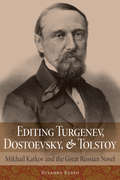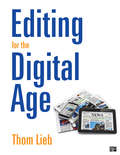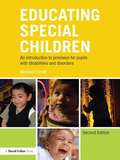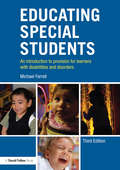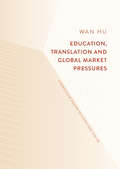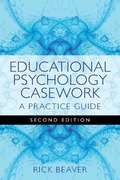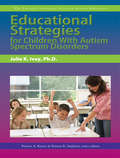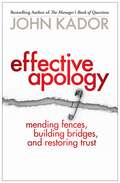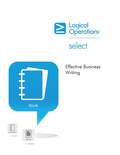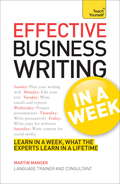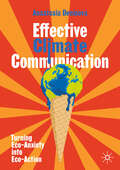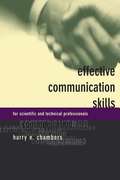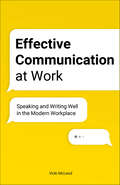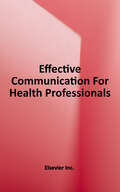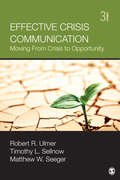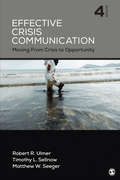- Table View
- List View
Editing Fiction: Three Case Studies from Post-war Australia (Elements in Publishing and Book Culture)
by Alice GrundyEditing Fiction considers the collaborative efforts of literary production as well as editorial practice in its own right, using case studies by Australian novelists Jessica Anderson, Thea Astley and Ruth Park. An emphasis on collaboration is necessary because literary criticism often takes books as finite, discrete works rather than the result of multiple contributors, engaged to differing degrees. The editorial process always involves a negotiation over edits for the sake of the work, taking its potential reception or projected sales into account. Through examination of the archives, this Element shows that editing can be formative, limiting, commercially directed, a literary collaboration – or a mix of all these interventions. For editors and scholars alike, the Element examines practices of the recent past, seeking to determine the responsibilities of editors and publishers to authors, the text itself and to society; and the interrelation of editorial work, social conditions and market forces.
Editing Turgenev, Dostoevsky, and Tolstoy: Mikhail Katkov and the Great Russian Novel (NIU Series in Slavic, East European, and Eurasian Studies)
by Susanne FussoFathers and Sons by Turgenev. Anna Karenina by Tolstoy. Crime and Punishment by Dostoevsky. These are a few of the great works of Russian prose that first appeared in the Russian Herald, a journal founded and edited by Mikhail Katkov. Yet because of his conservative politics and intrusive editing practices, Katkov has been either ignored or demonized by scholars in both Russia and the West. In Putin's Russia, he is now being hailed as the "savior of the fatherland" due to his aggressive Russian nationalism. In Editing Turgenev, Dostoevsky, and Tolstoy, Susanne Fusso examines Katkov's literary career without vilification or canonization, focusing on the ways in which his nationalism fueled his drive to create a canon of Russian literature and support its recognition around the world. In each chapter, Fusso considers Katkov's relationship with a major Russian literary figure. In addition to Turgenev, Dostoevsky, and Tolstoy, she explores Katkov's interactions with Vissarion Belinsky, Evgeniia Tur, and the legacy of Aleksandr Pushkin. As a writer of articles and editorials, Katkov presented a clear program for Russian literature: to affirm the political and historical importance of the Russian nationality as expressed through its language. As a powerful and entrepreneurial publisher, he also sought, encouraged, and paid for the writing of the works that were to embody that program, the works we now recognize as among the greatest achievements of Russian literature. This groundbreaking study will fascinate scholars, students, and general readers interested in Russian literature and literary history.
Editing for Today's Newsroom: A Guide for Success in a Changing Profession
by Carl Sessions SteppEditing for Today's Newsroom provides training, support and advice for prospective news editors. Through history, analyses, and anecdotes, this book offers a solid grounding to prepare potential editors for the full range of their responsibilities in today's newsrooms: developing ideas; evaluating and editing copy; working with writers; determining what is news; understanding presentation and design; directing news coverage; managing people; making decisions under pressure; and coping with a variety of ethical, legal, and professional considerations, all while operating in today’s multimedia, multiplatform news arena. Author Carl Sessions Stepp focuses on editors as newsroom decision makers and quality controllers; accordingly, the book features strategies and techniques for coping with a broad spectrum of editing duties. Covering basic and advanced copyediting skills, it also provides intellectual context to the editor's role, critically examining the history of editing and the changing job of the contemporary editor.
Editing for Today's Newsroom: New Perspectives for a Changing Profession
by Carl Sessions SteppThrough anecdotes, history, and analysis, this book offers sound advice to prepare prospective editors for the full range of their duties: editing copy, determining what is news, understanding graphics and design, directing coverage, managing people, and coping with a spectrum of ethical and legal dilemmas.
Editing for the Digital Age (20160101 #05 College/higher education)
by Thom LiebA Balanced Approach for the Modern Writer and Editor Whether working in a traditional newsroom or as a one-person blogging operation, every good writer needs to become his or her own best editor. Editing for the Digital Age provides editors and writers with the tools necessary to ensure that published material is accurate, readable, and complete. The book provides guidance in copy editing fundamentals, including correcting grammar, conforming the writing to a style guide, and revising material so that it is tightly written and clear. The text is designed for today’s digital publishing landscape and addresses the many issues writers and editors now face on a daily basis—handling legal issues such as liability, copyright, and libel; writing headlines that will attract readers; creating multimedia packages to support an article or post; and using various forms of social media to curate content and connect with audience members. Chapters focus on key areas and themes for editing in the digital age, and "Write Right" writing and grammar exercises are woven into every chapter to progressively build students’ editing skills.
Editing for the Digital Age (20160101 #05 College/higher education)
by Thom LiebA Balanced Approach for the Modern Writer and Editor Whether working in a traditional newsroom or as a one-person blogging operation, every good writer needs to become his or her own best editor. Editing for the Digital Age provides editors and writers with the tools necessary to ensure that published material is accurate, readable, and complete. The book provides guidance in copy editing fundamentals, including correcting grammar, conforming the writing to a style guide, and revising material so that it is tightly written and clear. The text is designed for today’s digital publishing landscape and addresses the many issues writers and editors now face on a daily basis—handling legal issues such as liability, copyright, and libel; writing headlines that will attract readers; creating multimedia packages to support an article or post; and using various forms of social media to curate content and connect with audience members. Chapters focus on key areas and themes for editing in the digital age, and "Write Right" writing and grammar exercises are woven into every chapter to progressively build students’ editing skills.
Editing in the Modern Classroom (ATTW Series in Technical and Professional Communication)
by Michael J. Albers Suzan FlanaganEditing in the Modern Classroom is a research‐based collection that defines the current state of technical editing pedagogy and plots a potential roadmap for its future. It examines current academic and professional editing practices, the global and corporate contexts of technical communication programs, and the role of new challenges such as content management in order to assess what should be expected from editing courses today and how instructors can best structure their courses to meet these expectations. It provides a research foundation to determine where changes are needed, and points to areas where additional research must be done to support further curricular and pedagogical innovations. Editing in the Modern Classroom challenges instructors to look deeper at the pedagogical aspects of what makes up an effective technical editing course at undergraduate and graduate levels and provides them with comprehensive and evidence-based resources to design and teach these courses.
Educating Special Children: An introduction to provision for pupils with disabilities and disorders
by Michael FarrellEducating Special Children is the definitive guide to evidence-based practice and professionally informed approaches in provision for special children. Now in its second edition, this book outlines ideas of best practice that relate to various disabilities and disorders and helpfully discusses what might constitute effective provision. International in its scope, it explores issues surrounding: communication disorders and autism and Asperger's Syndrome developmental co-ordination disorders reading, writing and mathematics disorders disorders of conduct, anxiety and depression attention deficit hyperactivity disorder mild, moderate to severe, and profound cognitive impairment sensory impairments orthopaedic and motor disabilities, health impairments and traumatic brain injury. This new edition has also been updated to cover: entitlement to special education global examples of distinctive provision raising standards in your setting basic brain anatomy and physiology 'thinking points' and further reading list for reflection. Educating Special Children will be of interest to all students of special education, professionals and others interested in gaining an understanding in the challenging field of offering provision for special children.
Educating Special Students: An introduction to provision for learners with disabilities and disorders
by Michael FarrellEducating Special Students is the definitive guide to evidence based practice and professionally informed approaches to provision for special students. Now in its third edition, the book sets out ideas of best practice relating to different disabilities and disorders, helpfully discussing what might constitute effective provision. This edition has been updated to take account of new ways of classifying disabilities and disorders, and recent developments in research and practice, including the 2014 SEND Code of Practice (England) and the Diagnostic and Statistical Manual of Mental Disorders Fifth Edition DSM-5TM. A new appendix provides information on basic anatomy and physiology. International in scope, the book explores issues relating to: intellectual disability (profound, moderate to severe, and mild) sensory impairments orthopaedic impairment and motor disorders, health impairments, and traumatic brain injury oppositional defiant disorder, conduct disorder, anxiety disorders, depressive disorders, and attention deficit hyperactivity disorder communication disorders (speech, grammar and comprehension, semantics and pragmatics), and autism spectrum disorder specific learning disorders with impairment in reading, written expression and mathematics, and developmental co-ordination disorder. Educating Special Students will be of interest to all those studying special education, professionals, and others committed to seeking the best provision for special students.
Education of English Language Learners
by Louise Wilkinson Marilyn ShatzThis comprehensive volume describes evidence-based strategies for supporting English language learners (ELLs) by promoting meaningful communication and language use across the curriculum. Leading experts explain how and why learning is different for ELLs and pinpoint specific best practices for the classroom, illustrated with vivid examples. Particular attention is given to ways in which learning English is intertwined with learning the student's home language. The book addresses both assessment and instruction for typically developing ELLs and those with language disabilities and disorders. It demonstrates how educators and speech language professionals can draw on students' linguistic, cognitive, sociocultural, and family resources to help close the achievement gap.
Education, Translation and Global Market Pressures: Curriculum Design In China And The Uk
by Wan HuThis book investigates the market-driven transformation of the higher education sector and the response given by the translation programmes in the UK and China, two vastly different social and economic contexts. It provides an in-depth look at six selected case studies, critically analysing how social, economic, and political factors have affect curriculum designs in different translation programmes. This innovative volume contributes to the development of knowledge in an important area of translation studies and opens a new way for providing both cross-national and cross-disciplinary perspectives in analysing the curricula of translation programmes.
Educational Psychology Casework
by Rick BeaverEducational Psychology Casework is a practical, accessible guide to working with children, outlining the basic skills needed and practical strategies to promote positive change and obtain the best results for children. The book covers how to develop skills such as establishing rapport, gaining a child's trust and respect, interviewing skills and techniques, and interpreting children's responses. The author outlines the theoretical background and how this translates into practical work and includes case examples which demonstrate the theory in practice. This fully updated second edition includes new chapters on problem-solving versus solution-focused work and also on measures of impact. This book is essential reading for all trainee and practising educational psychologists.
Educational Strategies for Children With Autism Spectrum Disorders
by Julie K. IveyFocusing on educational and instructional strategies that are successful with students with autism spectrum disorders, Educational Strategies for Children With Autism Spectrum Disorders profiles the most current, research-based interventions that can be implemented by teachers in a classroom setting. Because autism spectrum disorders are on a continuum, educational placements can range from specialized autism classrooms to full-time inclusion in a general education classroom. It is important for teachers and staff to understand the various educational strategies that are available. It is the goal of this book to provide interventions and strategies to help teachers and staff best serve students on the autism spectrum. Strategies include applied behavior analysis, the Developmental, Individual Difference, Relationship-Based (DIR) model, discrete trial training, Picture Exchange Communication System (PECS), Pivotal Response Treatment (PRT), Sensory Integration Therapy, and Social Stories, among others.
Edward R. Murrow and the Birth of Journalism
by Bob EdwardsThis is a biography of Edward R. Murrow written by one of NPR's most respected journalists, Bob Edwards, best known for hosting Morning Edition.
Effective Apology: Mending Fences, Building Bridges, and Restoring Trust
by John KadorThere’s nothing easy about apology. The news is filled with examples of leaders apologizing, needing to apologize, or failing miserably at the attempt. And certainly we all have occasion to apologize ourselves—maybe more often than we realize. But we don’t need more apologies, says John Kador—we need better ones. Too many people just go through the motions, missing out on the power of apology to restore strained relationships, create possibilities for growth, and generate better outcomes for all. Effective Apology challenges you to think about the fundamental value and importance of apology as it delivers detailed advice for making an apology that truly heals and renews. Kador explores the Five Rs of apology: Recognize the wrong and the person harmed; accept moral Responsibility for your actions; express Remorse; provide meaningful Restitution; and offer assurance that the offense will not be Repeated. Making apology work in the real world—when and how to apologize, in what medium, and how to make it stick—is made clear through over seventy examples of good and bad apologies drawn from the news, popular culture, and the experiences of Kador, his clients, and his friends. The willingness to apologize signals strength, character, and integrity. Effective leadership is impossible without effective apology. John Kador shows how to craft and deliver a confident apology that will defuse resentment, reduce litigation, create goodwill, and transform a relationship ruptured by mistrust and disappointment into something stronger and more durable than it ever was before.
Effective Business Communication For Dummies
by Jill SchiefelbeinMake sure your voice gets heard in any situation—and learn to listen, too Effective Business Communication For Dummies gives you the tools you need to communicate better, both in and outside of the office. You want to build strong relationships, and you’ll need strong communication skills to do it. This book demystifies active listening, assertive speaking, conflict resolution, virtual team leadership, and all the other things you’ll need to know to get your point across. Thanks to the classic, friendly Dummies style, it’s easy to make an impression in e-mails, presentations, virtual events, and in person. Check out these tips from a top communications coach to discover the maser communicator inside you. Learn when to speak less and listen more—and how to listen actively Find win-win solutions, ace interviews, and handle other challenging situations Master global communication with international and intercultural communication tips Be assertive and stay on track in e-mails, letters, virtual meetings, and beyondWith Effective Business Communication For Dummies, you'll know what to say, how to say it, and when to talk less and listen more. This is the perfect guide for team members and leaders alike who want to communicate better in all life’s situations.
Effective Business Writing
by Edward SchelbThe topics covered in this books are: writing email and other electronic communication, writing effective business communication, writing a business letter and writing business proposals.
Effective Business Writing in a Week: Teach Yourself
by Martin ManserMost of us spend hours every day typing emails and other documents at work, yet howmany of us have ever had any training in writing skills? New and aspiring managersfind themselves having to write advertising copy or press releases, while manybusinesses want to engage successfully online. Effective Business Writing in a week isa practical guide to better communication at work, whether through more traditionalforms such as business reports or through email, websites and social media.Keywords:StyleStructureEmailBusiness reportsPresentationsLettersAdvertisingPress releasesLetterssocial mediawebsite copy
Effective Business Writing in a Week: Teach Yourself
by Martin ManserMost of us spend hours every day typing emails and other documents at work, yet howmany of us have ever had any training in writing skills? New and aspiring managersfind themselves having to write advertising copy or press releases, while manybusinesses want to engage successfully online. Effective Business Writing in a week isa practical guide to better communication at work, whether through more traditionalforms such as business reports or through email, websites and social media.Keywords:StyleStructureEmailBusiness reportsPresentationsLettersAdvertisingPress releasesLetterssocial mediawebsite copy
Effective Climate Communication: Turning Eco-Anxiety into Eco-Action
by Anastasia DenisovaThis book explores the urgent challenges of communicating climate change in the media. While many books have been written about climate change, this book goes to the very heart of what makes humans care about stories enough to act. In a direct and sympathetic approach, Denisova tackles problems of greenwashing, news narratives, colonial framings and more. Taking climate anxiety as a starting point, the author positions herself with empathy and asks the question: ‘what slows down citizen action?’ This fresh perspective acknowledges the pressing challenge of public disengagement and the anxiety people feel when faced with increasingly bleak headlines as the climate crisis intensifies. There is a surprising challenge to apocalyptic storytelling and a hero’s narrative, which Denisova argues are counter-productive, while solutions are provided for media storytellers. This book is essential reading for anyone seeking to ease climate-related anxiety and foster a deeper sense of empowerment in their audience.
Effective Communication Skills: For Scientific And Technical Professionals
by Harry E. ChambersFlatter, more collaborative organizational structures, combined with the pressure to translate innovative ideas into action quickly, are increasing the need by technical professionals-such as computer programmers, design specialists, engineers, and R&D scientists-to expand their repertoire of communication and managerial skills. In this highly accessible and practical book, Harry Chambers offers a wealth of strategies and tactics for building these skills, to the benefit of individuals, teams, and companies. In his trademark shoot-from-the-hip style, Chambers identifies specific real-world challenges that technical professionals face in the workplace, and offers definitive guidelines for enhancing their communication skills-from making presentations to giving and receiving criticism to navigating office politics. Featuring interviews with people in the trenches, as well as self-assessment tools and exercises, Effective Communication Skills will become a valued resource for technical professionals and their colleagues, trainers, and HR departments in all industries.
Effective Communication at Work: Speaking and Writing Well in the Modern Workplace
by Vicki McLeodDevelop effective communication skills for the office—in-person and onlineIn the digital age, as workers increasingly go remote, the ability to communicate clearly and effectively is—now more than ever—a highly desirable skill. Whether you talk, text, or email, Effective Communication at Work has everything you need to help boost your workplace performance and productivity.From honing listening to polishing speaking and writing skills, this essential guide delivers simple, powerful strategies and timely tips that can help you increase the impact of your business communication and correspondence both online and offline. Learn how to build stronger relationships and advance your career by mastering the art of effective communication.Effective Communication at Work includes:Expert advice—Get the latest tips for working and communicating in the digital world.Clarity is king—Discover a variety of effective communication styles and formats, including writing and speaking, with simplicity and accuracy.Cultivating relationships—Learn best practices for becoming a better human while working with others in an office environment, including mindfulness, empathy, diversity, and self-awareness.Gain a competitive edge by harnessing the power of effective communication.
Effective Communication for Health Professionals
by Elsevier IncEnsure you have the skills to effectively communicate with patients and other healthcare professionals! With its easy-to-read style, Effective Communication for Health Professionals, 2nd edition, is loaded with useful tips and exercises to help you learn the universal (and necessary) practice of communication. This full-color second edition reflects current therapeutic techniques, including Communication Guidelines feature boxes, Words at Work dialogue boxes, added case studies, and all-new content exploring the most current communication tools in the modern health care setting. In addition, interactive exercises on the Evolve companion website encourages you to practice therapeutic communication techniques in real-life situations. - UNIQUE! Interactive activities on accompanying Evolve site include a variety of application exercises such as scenarios with voice mail messages and patient/caregiver interviews. - Easy-to-read style provides practical information, hints, and tips. - Test Your Communication IQ boxes provide you with a short self-assessment test at the beginning of each chapter. - Spotlight on Success boxes provide you with useful, practical tips for improving workplace habits and communication. - Expanding Critical Thinking boxes provide actual case examples and activities with useful tips to help you apply what you've learned to practice. - Legal Eagle boxes provide useful tips that focus on honesty, as well as ethical and legal communication between patients and healthcare workers. - End-of-chapter questions and exercises help you to use knowledge learned from topics presented in the chapter. - NEW! Chapter devoted to cross-cultural communication promotes understanding of care in a diverse workplace - NEW! Chapter on diseases and disorders discusses communication with patients experiencing specific physical and mental illnesses and disorders. - NEW and UNIQUE! Words at Work dialogue boxes demonstrate actual conversations between healthcare workers and clients. - UPDATED! Content reflects the most current communication tools for the modern healthcare setting. - NEW! Full-color design and art program promote engagement. - NEW and UNIQUE! Communication Guidelines boxes direct you to best practices for the effective exchange of information. - NEW! Additional Taking the Chapter to Work case studies demonstrate real-life communication pitfalls and successes.
Effective Crisis Communication: Moving From Crisis to Opportunity
by Matthew W. Seeger Dr Robert R. Ulmer Dr Timothy L. SellnowIn this fully updated Third Edition, three of today’s most respected crisis/risk communication scholars provide the latest theory, practice, and innovative approaches for handling crisis. This acclaimed book presents a clear understanding about how to manage risks and crises effectively. The authors provide 18 in-depth case studies that highlight successes and failures in dealing with core issues of crisis leadership, managing uncertainty, communicating effectively, understanding risk, promoting communication ethics, enabling organizational learning, and producing renewing responses to crisis. Unlike other crisis communication texts, this book answers the question, “What now?” and explains how organizations can and should emerge from crisis. Authors Robert R. Ulmer, Timothy L. Sellnow, and Matthew W. Seeger provide guidelines for taking the many challenges that crises present and turning those challenges into opportunities.
Effective Crisis Communication: Moving From Crisis to Opportunity
by Matthew W. Seeger Dr Robert R. Ulmer Dr Timothy L. SellnowIn this fully updated Fourth Edition of Effective Crisis Communication, three of today’s most respected crisis/risk communication scholars provide the latest theories and innovative approaches for handling crisis. Unlike other crisis communication texts, this acclaimed book answers the question, “what now?” and explains how organizations can create the potential for opportunity, renewal, and growth through effective crisis communication. Authors Robert R. Ulmer, Timothy L. Sellnow, and Matthew W. Seeger provide guidelines for taking the many challenges that crises present and turning those challenges into opportunities. Practical lessons and in-depth case studies highlight successes and failures in dealing with core issues of crisis leadership, including managing uncertainty, communicating effectively, understanding risk, promoting communication ethics, enabling organizational learning, and producing renewing responses to crisis. New to the Fourth Edition: New and updated examples and case studies include diverse cases from recent headlines such as SeaWorld’s reaction to Blackfish, the United Airlines debacle, and the Flint Water Crisis. Updated theories and references throughout provide you with the latest information for effective crisis communication.

